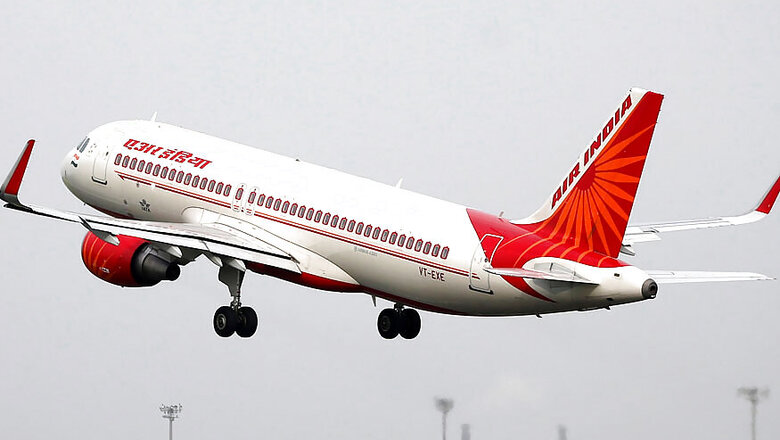
views
New Delhi: The government is preparing to initiate strategic disinvestment of Air India (AI) once again, after an earlier attempt at a sale had bombed. At that time, not a single bid was received for the airline.
The biggest roadblocks to AI sale include the remaining debt on its books, even after roughly half the debt has been transferred to a Special Purpose Vehicle (SPV). Its accumulated losses exceeding Rs 50,000 crore and nervousness among potential investors about the government wanting to again hold on to a minority stake in the airline are other irritants. But after the first attempt at AI sale had bombed, the government had gone ahead and initiated the sale of AI’s profit-making, ground handling subsidiary in February this year. A preliminary information memorandum (PIM) for the sale of Air India Air Transport Management Ltd (AIATSL) had been issued then.
However, the process for AIATSL remains stuck. An official close to developments said potential investors asked a number of queries as part of the sale process and these were yet to be answered. The PIM has seen five corrigenda, the last one being issued last month. This one pushes the date of completion of the process to the end of August versus April initially.
The official quoted above said concerns over the status of AIATSL remained even as the government had not moved to initiate a similar sale of AISATS, the separate ground-handling joint venture of AI with SATS of Singapore.
“First of all, why did the government want to offload a profit-making arm of Air India, when the airline itself remains unsold? This question begs an answer. Second, what will be the status of AIATSL? It is currently a subsidiary of AI. Will it remain a subsidiary after its own disinvestment? What will be its status if the airline (AI) is divested first? These fundamental questions remain,” the official said.
This person also wondered why the government had not initiated the sale of AISATS, in which it holds 50% stake and where SATS holds the first right of refusal. AIATSL has rights to do ground handling at 76 Indian airports while AISATS has the rights for only a handful of the remaining airports.
Prospective investors too have several concerns over AIATSL’s future. They want clarity on what can be done to reduce its existing staff, what will be AIATSL’s relationship with AI after the former is disinvested, how things will pan out if AIATSL is divested first and Air India is not and vice-versa. Investors also want clarity on how many years post the divestment of AIATSL will the company be allowed to work for AI and whether the agreement with AI on rates at which services are to be provided stays.
The government has, meanwhile, initiated an amendment to the clause in the AAI (Ground Handling Services) Regulations, 2018, where it might extend the period for which any ground handling agency operating at Indian airports may continue to operate even if it ceases to be a subsidiary or a 50% partner with a PSU. This amendment may address some concerns of prospective bidders.
AIATSL has been declaring net profit since it became an autonomous company in 2014-15. That year, the net profit was Rs 90.7 crore and subsequently, it reported a net profit of Rs 101.4 crore, Rs 61.7 crore and Rs 122.2 crore in three subsequent fiscal years till 2017-18. The company claims to be debt free.
Through the PIM, the government invited bids for offloading 98% stake in AIATSL. The PIM for AIATSL sale showed that the babus in Rajiv Gandhi Bhawan may have finally learnt some lessons from the AI sale debacle. One, 98% stake on offer means government would exit the ground handling subsidiary completely, since employees can bid for the remaining 2%. Two, instead of expecting the investor to take on a loss-making entity, the government offered investors a business which has consistently returned profits. AIATSL’s average earnings before interest, tax, depreciation and amortisation (EBITDA) margin has been around 19% and average PAT (profit after tax) margin has been around 11% for three financial years till 2017-18.
Three, AIATSL is a strong player in India’s fast-growing ground handling market since it works at 76 airports and controls just a little less than half the market (market share 47.7% in 2017-18). Four, nine in 10 employees are contract workers so any incoming investor may not feel as encumbered with employee issues as was the case in the AI disinvestment. Five, the PIM says AIATSL does not have any “significant” contingent liabilities as of March 31, 2018, and any changes would be provided in the request for proposal (RFP).
Basically, the company on offer has limited employee issues, has been turning in a small profit each year and has no significant liabilities. This should have made the sale attractive to prospective bidders had the government also ironed out sector-specific problems of ownership etc.
(The author is a senior journalist. Views expressed are personal)




















Comments
0 comment